Crucial Practice Problems for CBSE Class 11 Biology Chapter 5: Morphology of Flowering Plants
Free PDF download of Important Questions with Answers for CBSE Class 11 Biology Chapter 5 - Morphology of Flowering Plants prepared by expert Biology teachers from latest edition of CBSE(NCERT) books. Register online for Biology tuition on Vedantu.com to score more marks in your examination.






Boost your Performance in CBSE Class 11 Biology Exam Chapter 5 with Important Questions
Very Short Questions and Answers (1 Marks Questions)
1. Which part of opuntia is modified to form spines?
Ans: Leaves of opuntia are modified to form spines.
2. Name one plant in which the leaf is pinnately compound.
Ans: Neem is the plant where leaves are pinnately compound.
3. In mangroves, Pneumatophores are the modified adventitious roots How are these roots helpful to plants?
Ans: In mangroves, Pneumatophores are helpful in respiration.
4. Which part of mango fruit is edible?
Ans: Mesocarp of the mango fruit is edible.
5. Why do the various plants have different types of phyllotaxy?
Ans: Various plants have different types of phyllotaxy (arrangement of leaves on an axis or stem) for proper exposure of leaves to get sunlight.
6. State the main function of leaf tendril.
Ans: The main function of the leaf tendril is to help the plant for climbing.
7. Which plant family represents the following floral formula.
Given Floral formula
An: The following floral formula is represented by the family Liliaceae.
8. The endosperm is formed as a result of double fertilisation (triple fusion). What is its function?
Ans: The function of the endosperm is to store the food.
9. Which type of venation do you observe in the dicot leaf?
Ans: Reticulate venation is observed in the dicot leaf.
10. In pea flower, the a in corolla is known as vexillary. Give a reason.
Ans: Peas have five petals. The largest (standard) petal covers the two lateral (wing) petals that overlap the two smallest anterior petals in a series of overlaps (keel).
11. What is the name given to the cotyledon in the case of Monocots?
Ans: Scutellum is the name given to the cotyledon in the case of Monocots.
12. Name one monocot & one dicot in which endosperm is present?
Ans: One monocot and one dicot in which endosperm is present: -
(i). Monocot: - Maize grain
(ii). Dicot: - Castor oilseed.
13. Why is date palm referred to as dioecious?
Ans: Date palm is referred to as dioecious because male & female flowers are borne on different plants.
14. What is placentation?
Ans: Placentation refers to the arrangement of the ovules within the ovary.
15. Write the floral formula of Brassica Campestris.
Ans: The floral formula of Brassica campestris is:
Floral formula of Brassica Campestris
16. Why are cucumber flowers referred to as epigynous?
Ans: Flowers of cucumber are referred to as epigynous because the floral parts lie above the ovary and the ovary is inferior.
17. What is false fruit?
Ans: A false fruit is derived when the floral parts other than the ovary take part in the formation of fruit and become edible. It is also known as pseudocarp or accessory fruit.
18. What is the term used for a plant bearing both male & female flowers?
Ans: A plant bearing both male and female flowers is termed a monoecious flower.
19. What are runners?
Ans: A runner is defined as a long creeping stem with long internodes that runs horizontally on the surface of the soil.
20. Why are flowers of mustard referred to as hypogynous?
Ans: Flowers of mustard are referred to as hypogynous because the ovary is situated at the top and the other three whorls are inserted below the pistil.
21. Name the two layers of the seed coat.
Ans: The two layers of seed coat are testa (outer seed coat) and tegmen (inner seed coat).
22. Which family has characteristically a swollen axile placenta?
Ans: Family Solanaceae has characteristically a swollen axile placenta.
23. Why is the root system poorly developed in aquatic plants?
Ans: As there is no soil to anchor aquatic plants firmly, water absorption occurs through diffusion, and thus the root system is not fully developed.
24. Name two plants where seeds do not have endosperm?
Ans: Beans and peas are two plants whose seeds lack endosperm.
25. Which plant part has given rise to the following modifications: - (a) Spines of opuntia (b) Pitcher of Nepenthes.
Ans: The plant part has given rise to the following modifications: -
(a) Spines of opuntia: - Modified stem
(b) Pitcher of Nepenthes: - Modified leaf.
26. Why is the leaf of Neem called unipinnately compound.
Ans: Leaf of Neem is called unipinnately compound because leaflets are found in pairs on either side of the rachis.
Short Questions and Answers (2 Marks Questions)
1. Flower is a modified shoot. Justify.
Ans: The flower is considered to be a modified shoot because the internodes in a flower are highly condensed and therefore the number of appendages like sepals, petals, stamens, and carpels is generally large.
2. Name the type of root for the following:
a) Roots performing the function of photosynthesis.
Ans: Assimilatory roots
b) Roots come above the surface of the soil to absorb air.
Ans: Respiratory roots
c) The pillar-like roots develop from lateral branches for providing mechanical support.
Ans: Prop roots
d) Roots coming out of the lower nodes of the stem and provide support to the plant.
Ans: Stilt roots
3. Fill up the blank spaces (a), (b), (c) and (d) in the table given below:
Type of flower | Position of calyx, corolla and androecium in respect of the ovary on the thalamus | Type of ovary |
Hypogynous |
| Superior |
Perigynous | On the rim of the thalamus almost on the name level of the ovary. |
|
|
| Inferior |
Ans:
a) Floral parts are situated just below the ovary
b) Half inferior
c) Epigynous
d) Floral parts are situated just above the ovary
4. Provide the scientific terms for the following:
(i). The leaf without a petiole (stalk).
Ans: Sessile Leaf
(ii). The flat and expanded portion of a leaf.
Ans: Lamina or leaf blade
(iii). An orderly arrangement of leaves on the node.
Ans: Phyllotaxy
(iv). Lateral appendages on either side c the loaf.
Ans: Stipules
5. What is Rhizome? Give two examples.
Ans: The rhizome is a prostrate and a thickened underground stem having distinct nodes, internodes, scales, leaves as well as buds. It creeps horizontally under the ground. Example: Ginger and turmeric.
6. Differentiate between epigynous and perigynous flowers.
Ans: The difference between epigynous and perigynous flowers are: -
Epigynous flowers | Perigynous flowers |
The thalamus is cup-shaped and is fused with the ovary so that floral parts rise on the top of the ovary. | The thalamus is a cup-shaped structure around the ovary but is not fused and bears sepals, petals and stamens. |
The ovary is inferior. Example: - Apple and cucumber. | The ovary is half inferior. Example: - Rose. |
7. Give a reason to justify that the onion bulb is a modified stem?
Ans: The onion bulb is modified, highly condensed and disc-like. It possesses a large number of fleshy scale leaves, terminal buds as well as auxiliary buds. A cluster of adventitious roots is present on the lower posterior side. A cluster of adventitious roots is found on the lower posterior side.
8. What is the difference between alternate & whorled phyllotaxy.
Ans: The difference between alternate and whorled phyllotaxy is:
Alternate phyllotaxy | Whorled phyllotaxy |
At each node, only one leaf appears. | At each node, more than two leaves appear. |
Leaves appear alternately on the left and right sides of the stem. | Leaves grow in whorls from a single point. |
For example, China rose and mango. | For example, Nerium. |
9. Define venation? What are two types of venations?
Ans: Venation refers to the arrangement of veins in the leaf lamina. Venations are of the following two types: -
a) Parallel venation: - When veins are arranged parallel to each other on the lamina.
b) Reticulate venation: - When veins form a network on leaf lamina.
10. Why is the leaf of Bombax categorized as a palmately compound multifoliate leaf?
Ans: Bombax leaf is regarded as palmately compound multifoliate leaf because the petiole in pinnately compound leaf bears leaflets in its tips. In Bombax, five or more leaflets are articulated on a long axis. The shape of the leaf is similar to the palm of a hand. This type of leaf is known as digitate.
11. Explain with suitable examples the different types of phyllotaxy.
Ans: Phyllotaxy refers to the pattern or organization of leaves on a stem or branch. Alternate, whorled and opposite phyllotaxy are the three forms of phyllotaxy.
(i). Alternate Phyllotaxy: - In alternate phyllotaxy, a single leaf grows from a branch node. Example: Sunflowers, mustards, and peepal.
(ii). Opposite Phyllotaxy: - Plants with opposite phyllotaxy have two leaves that grow from the same node in opposite directions. Example: Guava and Jamun plants.
(iii. Whorled Phyllotaxy: - Plants with whorled phyllotaxy have three or more leaves that grow from a single node. Example: Alstonia and Nerium.
12. “Flower is a modified shoot.” justify the statement.
Ans: The flower is considered to be a modified shoot because the internodes in a flower are highly condensed and therefore the number of appendages like sepals, petals, stamens, and carpels is generally large.
13. Distinguish between prop root and stilt roots.
Ans: The difference between prop root and stilt roots are:
Prop Root | Stilt Root |
It arises from horizontal branches of a free stem. | It arises from the basal nodes of the stem. |
Long roots that provide support to plant-like pillars. | Short roots that grow downward obliquely to provide support to the stem, just like a tent rope. |
Example: Banyan tree. | Example: Maize and Jowar. |
14. What is inflorescence? What are its two types?
Ans: The arrangement of groups or clusters of flowers on the floral axis is called an inflorescence. Inflorescence are of two main types: -
i. Racemose Inflorescence: - In racemose inflorescence, the main axis continues to grow and produces flowers laterally. The flowers are arranged in an acropetal succession which means that older flowers are at the base and younger flowers are at the tip.
ii. Cymose Inflorescence: - The primary axis (floral axis) of a cymose inflorescence stops in a flower, limiting its expansion. The blooms are arranged in a basipetal pattern, with the elder flowers at the top and the younger flowers at the bottom.
15. Draw the floral formula & floral diagram of the family Solanaceae.
Ans:
(i). The floral formula of family Solanaceae: -
Floral formula of family - Solanaceae
(ii). Floral diagram of family Solanaceae: -
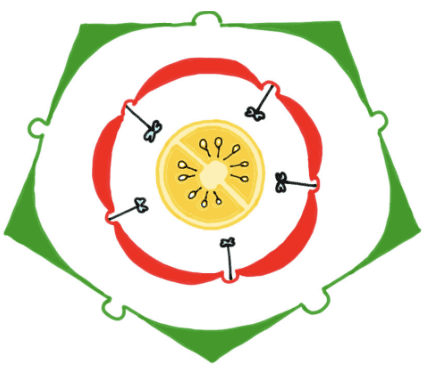
Floral diagram of Solanaceae
16. Differentiate between true fruit & false fruit.
Ans: The below-given table shows the difference between true fruit and false fruit:-
True Fruit | False Fruit |
It arises from the ovary. | It arises from floral parts other than the ovary. |
No other part is involved in the formation of fruit. | Thalamus and perianth are involved in fruit formation. |
For example, pea. | For example, apples. |
17. Write the floral formula & draw the floral diagram of the family Liliaceae.
Ans.
(i). The floral formula of family Liliaceae: -
Floral formula of family- Liliaceae
(ii).Floral diagram of family Liliaceae: -
Floral diagram of Family- Liliaceae
18. “Underground parts of a plant are not always roots” justify the statement.
Ans: Normally, roots grow beneath the ground. But, in the potato, the stem is modified into a tuber-like structure for the storage of reserve food material. These stem tubers develop and grow under the ground. Potato is a stem because it has scale leaves, nodes, buds etc.
19. How would you differentiate leaflets of a compound leaf from simple leaves on a branch?
Ans: The difference between the leaflets of a compound leaf and simple leaves on a branch are:
Simple Leaf | Compound Leaf |
There are no distinct lobes or leaflets in the lamina. | The lamina is made up of two or more leaflets. |
A simple leaf has an axillary bud in its axil. | The entire leaf has a bud in the axil. |
Simple leaves grow in acropetal succession on the stem. | The leaflets of a compound leaf are not arranged in acropetal succession. |
The base of the simple leaf may have stipules | Stipules may be present at the base of a compound leaf. |
Simple leaves appear in one or more planes. | Leaflets in a compound leaf only exist in one plane only. |
20. Draw a well-labelled diagram of V.S. of maize seed.
Ans:
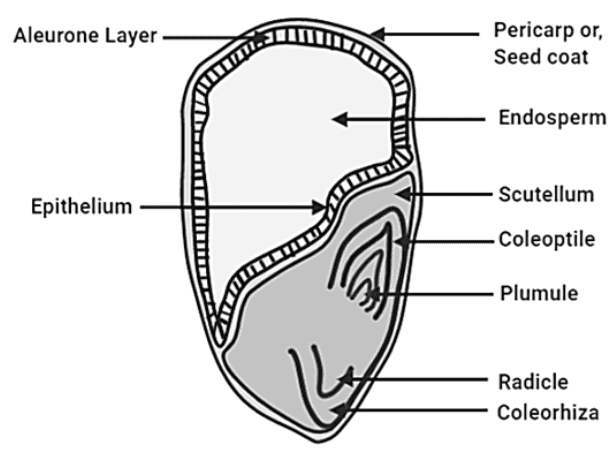
Diagrammatic representation of Vertical section of Maize leaf
21. Write differences between phyllode & phylloclade.
Ans: The difference between phyllode and phylloclade are:
Phyllode | Phylloclade |
Phyllode is a modification of petiole. | Phylloclade is a modification of a stem. |
Bears a bud in its axil. | Developed in the axil of the leaf. |
Nodes and internodes are found. | Nodes and internodes are not found. |
Does not possess leaves and flowers. | Has reduced bristles, spiny leaves and flowers. |
Long Questions and Answers (3 Marks Questions)
1. Observe the given figure showing various types of placentation. Identify the type of placentation. Give one example of each.

Various Types of Placentation
Ans: The type of placentation is: -
Marginal placentation: - Pea
Parietal placentation: - Argemone
Free central placentation: - Dianthus Primrose
2. Potato is a stem and a sweet potato is a root. Justify the statement on the basis of external features.
Ans: The stem of the potato has been modified to store food, and these modifications are known as stolon. The ends of the stolon swell to form tubers which is a swollen stem. Potato tubers have buds that sprout stems and leaves from them, whereas potato roots lack these characteristics. It has nodes (eyes) that are made up of one or more buds that are covered by a leaf scar. During sprouting, adventitious roots appear as well. On the other hand, sweet potato is a swollen adventitious root or tuberous root. It does not possess nodes, internodes and buds like a stem.
3. Define aestivation. Which type of aestivation is found in China rose, Calotropis, Gulmohar and pea?
Ans: The positional arrangement of petals or sepals in a floral bud before it is opened is known as aestivation.
(i) China rose: - Twisted
(ii) Calotropis: - Valvate
(iii) Gulmohar: - Imbricate
(iv) Pea: - Vexillary
4. Explain the different types of phyllotaxy. Give one example of each type.
Ans: The pattern or arrangement of leaves on the stem or branch is referred to as phyllotaxy. There are three types of phyllotaxy: alternate, opposite, and whorled.
(i). Alternate Phyllotaxy: - In alternate phyllotaxy, a single leaf grows from a branch node. Example: Sunflowers, mustards, and peepal.
(ii). Opposite phyllotaxy: - Plants with opposite phyllotaxy have two leaves that grow from the same node in opposite directions. Example: Guava and Jamun plants.
(iii). Whorled phyllotaxy: - Plants with whorled phyllotaxy have three or more leaves that grow from a single node. Example: Alstonia and NeriumAns.
5. Differentiate between:
a) Actinomorphic flower and Zygomorphic flower
b) Apocarpous ovary and Syncarpous ovary
c) Racemose inflorescence and Cymose inflorescence
Ans:
a) Actinomorphic flower and Zygomorphic flower
Actinomorphic flower | Zygomorphic flower |
The actinomorphic flower is a flower that has radial symmetry. | The zygomorphic flower is a flower that has bilateral symmetry. |
It can be divided into two equal halves along any diameter. | It can be bisected into two equal halves in one plane only. |
Example: Tulip and rose. | Example: Orchid and Gulmohar. |
b) Apocarpous Ovary and Syncarpous Ovary
Apocarpous ovary | Syncarpous ovary |
In flowers with an apocarpous ovary, more than one carpel is present, but these carpels are distinct, i.e., separate or unfused. | In flowers with a syncarpous ovary, more than one carpel is present, but these carpels are fused. |
It produces an aggregate of fruit. | It only produces a single fruit with one or more seeds. |
Example: Flowers of lotus, strawberry, rose, buttercup, etc. | Example: Flowers of tomato, mustard, mango, coconut, etc. |
c) Racemose Inflorescence and Cymose Inflorescence
Racemose inflorescence | Cymose inflorescence |
In racemose inflorescence, the main axis continues to grow and produces flowers laterally. | In cymose inflorescence, the main axis (floral axis) terminates in a flower, hence is limited in growth. |
The flowers are arranged in an acropetal succession which means that older flowers are at the base and younger flowers are at the tip. | The flowers are arranged in a basipetal manner which means that older flowers are at the tip and younger flowers are at the base. |
Example: Mustard and Snapdragon. | Example: Drosera and Hamelia. |
6. In the given structure of Monocotyledonous seed label the part a, b, c, d, e. Give the function of part ‘a’.
Given figure of monocotyledonous seed for labeling
Ans:
a) Endosperm
b) Scutellum
c) Coleoptile
d) Coleorhiza
e) Aleurone layer
Labeled diagram of Monocotyledonous seed
Endosperm's Function: - Throughout seed development and germination, the endosperm facilitates embryonic growth by delivering nutrients, shielding the embryo, and limiting embryo development by serving as a mechanical barrier.
7. Describe the parts of a typical angiosperm leaf?
Ans: The parts of a typical angiospermic foliage leaf are as follows: -
i. Leaf Base: -This is the region of the stem from which the leaf grows. Its primary function is to connect the leaf to the stem or branch.
ii. Petiole: - The stalk of a leaf is referred to as the petiole. Petiolate leaves are those that have a petiole. Some leaves, like the banyan leaf, may be devoid of petioles.
iii. Lamina: - The green, flattened part of the leaf attached to the petiole is referred to as the lamina. It is responsible for photosynthesis, respiration, and transpiration. In the middle of the lamina, there is a midrib. The midrib of a compound leaf is referred to as the rachis. In different types of leaves, the lamina is of different shapes and sizes.
Structure of Angiosperm leaf
8. Differentiate between a maize grain and a bean seed?
Ans: The difference between a maize grain and a bean seed are:
Maize Grain | Bean Seed |
Maize grain is a single-seeded fruit called the caryopsis. | Bean seed is a true seed that develops inside a fruit called a pod or legume. |
The fruit wall, also known as the pericarp, is fused with the testa. | The fruit wall or pericarp is testa-free. |
There is only one seed coat that is fused to the pericarp and is inseparable. | Seed coats are divided into two types: testa and tegmen. They are fused. |
The maize grain is endospermic | The bean seed is non-endospermic. |
The maize grain has no hilum, micropyle and chalaza. | The chalaza, hilum and micropyle are present in bean seed. |
Ridge like raphe is absent. | The raphe is present. |
The plumule and radical are protected by different sheaths known as coleoptile and coleorhiza, respectively. | There is no such protective coating around the plumule and radical. |
The cotyledon is an absorbing structure that absorbs nutrients from the endosperm and transports it to the embryo. | Cotyledons are nothing more than food storage organs. |
9. Describe the arrangement of floral members in relation to their insertion on the thalamus.
Ans: The position of the calyx, corolla, and androecium in reference to the ovary on the thalamus is used to classify flowers into three categories:
a) Hypogynous Flowers: The gynoecium is at the top of the flower while the rest of the whorls lie below it. Example: - Mustard, China rose, etc.
b) Perigynous Flowers: The gynoecium is in the centre while the rest of the whorls of the flower are situated on the rim of the thalamus. They all lie almost at the same level. The ovary is half inferior. Example: Plum and rose.
c) Epigynous Flowers: - The margins of the thalamus grow upwards enclosing the ovary completely. The rest of the whorls of the flower arise above the ovary. The ovary is inferior. Example: Guava, sunflower and Cucumber.
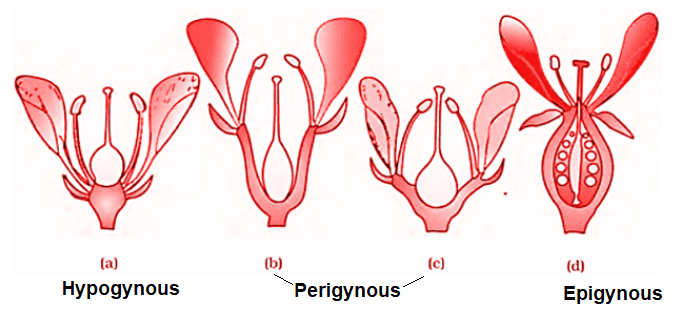
Classification of flowers based on position of floral parts on thalamus
10. How is a herbaceous stem different from a woody stem?
Ans: The difference between herbaceous stem and woody stem are:
Herbaceous Stem | Woody Stem |
Annual or biennial, with a short lifespan. | It is always perennial and long-lived. |
Herbaceous stems are green, soft and fleshy. It does not break on bending. | Woody stems are brown or greyish and hard. It breaks on bending. |
The outer covering is formed by the protecting superficial layer epidermis. | A corky layer or bark replaces the epidermis. |
Stomata are present along its entire length for gaseous exchange. | For gaseous exchange, it develops lenticels, which are dot-like pores. |
Buds are commonly naked. | Buds are commonly protected by scales. |
They are made up of primary, permanent tissues. | They are made up of secondary, permanent tissues. |
11. How do various leaf modifications help plants?
Ans: Photosynthesis, transpiration, and respiration are the three basic functions of leaves. Apart from these functions, the leaves have to perform other functions too. As a result, leaves modify themselves in the following ways:
i. Tendrils: In some plants, the entire leaf or a portion of it is transformed into a coiled thread-like structure known as a tendril. Tendrils help plants in climbing. Example: Peas and clematis.
ii. Spines: - In many plants, the leaves are modified into thin sharp and pointed structures called spines. They play a major role in defence. Example: Opuntia and Yucca.
iii. Scale Leaves: - Onions have predominantly fleshy scale leaves.
iv. Pitcher: It is an adaptation of an insectivorous plant, in which the lamina takes the shape of a pitcher and the apex takes the shape of a lid to capture the insects. The inside walls of the pitcher have several digestive glands. These glands release a fluid that helps in the digestion of insects. Example: Nepenthes.
v. Phyllode: The petiole of some plants, such as Australian Acacia, turns green, flattens, and resembles a leaf.
12. Differentiate between Tuber & Bulb.
Ans: The difference between Tuber and Bulb are:
Tuber (Potato) | Bulb (Onion) |
The stem is well developed in the tuber. | The stem is reduced to a disc-like structure in the bulb. |
Adventitious roots are absent in tuber. | Adventitious roots are present in the bulb. |
Potato plants can bear numerous tubers. | In a single onion plant, just one bulb grows. |
In the tuber, food is stored in the stem. | In the bulb, food is stored in fleshy scale leaves. |
Buds are external. | Buds are internal. |
Distinct nodes and internodes are present. | Nodes and internodes are not distinct. |
In the nodal region, scale leaves are quite tiny. | Scale leaves are fleshy. |
The tuber (potato) is a total stem. | The bulb (onion) is a shoot. |
13. Give four types of underground stem and give examples for each.
Ans: Four types of underground stems are: -
i. Rhizome: - The stem is thickened, prostate, and grows horizontally beneath the soil. The stem is branched & each branch ends in the terminal bud. Adventitious roots arise in profusion. Example: - Fern, water lily, turmeric etc.
ii. Bulb: - Highly condensed & discoidal stem. Terminal bud in the centre produces an aerial root that produces flowers. From the base of the stem adventitious roots develop. Leaves store food material. Terminal buds and scale leaves are present. Example: - Onion and garlic.
iii. Corm: - A condensed form of rhizome with auxiliary buds & scale leaves. It is known to be the swollen base of the underground stem axis. Nodes and internodes are present. Example: - Jimikand, Saffron, Colocasia.
iv. Tuber: - It grows horizontally and swells at the apex. Adventitious roots arise during sprouting. It has numerous buds that develop into new plants. Example: - Potato, Helianthus.
14. Compare Trailer, runner and sucker.
Ans: The difference between the trailer, runner and sucker are:
Trailer | Runner | Sucker | |
Semi aerial creeping stem. It does not have roots at intervals. | Prostate, sub-aerial stem. It is green and roots are present at intervals. | Underground and non-green stems. | |
The trailer does not participate in perennation. | A runner does not participate in perennation. | Suckers help in perennation. | |
No help in vegetative propagation. | Helps in vegetative propagation. | Helps in vegetative propagation. |
15. What do you mean by “modification of roots”? Describe some of the modifications of tap roots giving suitable examples.
Ans: The root is a part of the plant that grows beneath the ground. It absorbs water and minerals from the soil and serves as a strong anchor for the plant.
The roots of some plants change shapes and are modified to absorb water and minerals from the soil. It transports them to different parts of the plant. They are also modified for providing support, storing food, and to perform respiration. These are called modifications of roots. The modifications of taproots include:
a) Fusiform Root: - This root is swollen in the centre and tapers towards both ends. Example: - Radish.
b) Napiform Root: This root's shape becomes almost spherical and tapers towards the apex. Example: - Turnip.
c) Conical root: - The shape becomes cone-like i.e., broad at the base and conical at the apex. Example: - Carrot.
d) Tuberous Root: - It is a swollen root having no distinct shape. It appears thick and fleshy. Example: - Mirabilis, Trichosanthes.
16. What is aestivation? What are its different types and give examples?
Ans: Aestivation is the positional arrangement of sepals or petals in a floral bud. Different types of aestivations are: -
(a) Valvate Aestivation: - Petals or sepals meet each other at the edge. They are arranged without overlapping. Example: - Guava and mustard.
(b) Twisted Aestivation: - The overlapping of petals or sepals is done by one margin of each petal over the margin of adjacent petals. Example: - China Rose and cotton.
(c). Imbricate Aestivation: -The margins of sepals and petals overlap. They do not overlap in a specific direction. Example: - Cassia and Gulmohar.
(d). Quincuncial Aestivation: - The arrangement in which out of five parts of the flower, two petals or sepals are positioned internally, two petals or sepals are positioned externally, and the fifth part is situated externally at the margin. Example: - Guava.
(e).Vexillary Aestivation: - There are five petals. The largest petal overlaps the 2 lateral petals which successively overlap the 2 smallest anterior petals. Example: - Bean and pea.
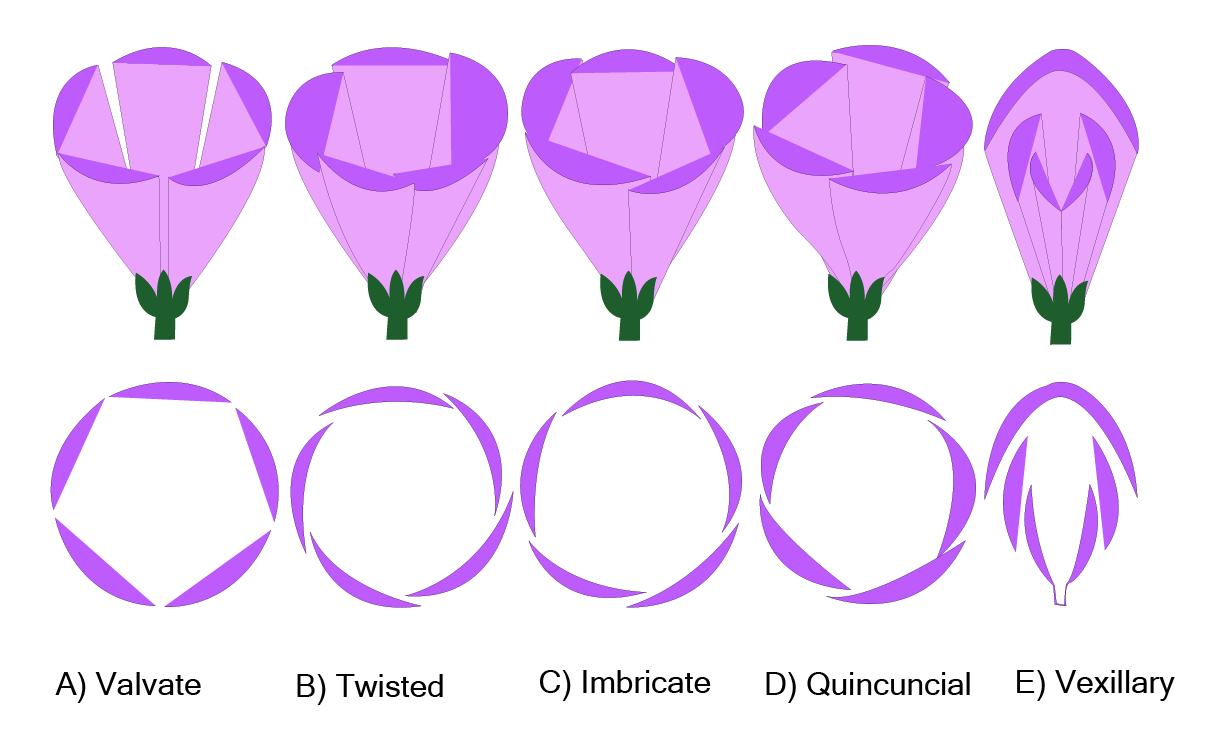
Different Types of Aestivation
17. Describe the sub-aerial modifications of the stem.
Ans: The primary function of sub-aerial stem modification is vegetative propagation. They are classified as follows: -
a) Runners: - These stems are long and thin, with branches. They creep along with the ground and form roots at nodes. The mother plant produces a large number of such branches, which spread out in all directions. They may break off and start living as independent plants. Example: - Oxalis and doob grass.
b) Stolon: - Stolon is a thin lateral branch that emerges from the base of the stem. It grows upward and then bends down, developing roots at the tip and producing a bud. The bud develops into a new plant. Example: - Mint and strawberry.
c) Offset: - Offset is a thickened horizontal branch that emerges from the axil of a lower leaf. It is a short branch with a cluster of leaves above and tufts of roots below. The offset can detach from the mother plant and begin living on its own. Example: - water hyacinth and Water lettuce.
d) Sucker: - The sucker is a lateral branch that grows from the underground portion of the stem. It grows obliquely upward and directly produces new plants. Example: - Banana and pineapple.
18. What are the different modifications of adventitious roots? Explain with examples.
Ans: Modifications of adventitious roots are: -
a) Tuberous Root: It is a swollen root with no specific shape. Example: - Sweet potato.
b) Fasciculated Root: - It is a cluster of tuberous roots that emerges from the same location. They have a specific shape. Example: - Dahlia and Asparagus.
c) Beaded Root: These roots have swollen parts that appear at regular intervals. Example: - Portulaca and Vitis.
d) Prop Root: These are pillar-like roots. They hang vertically downward from an aerial branch of a plant. Example: - Banyan tree.
e) Stilt Root: - The roots are short and grow obliquely from near the base of the main stem. They give the stem stability and support. Example: - Sugarcane, maize and sorghum.
f) Parasitic Root: These roots penetrate the host cells and absorb nutrients from the host tree. Example: - Cuscuta.
g) Assimilatory Root: Adventitious roots of some plants turn green to perform photosynthesis and are referred to as assimilatory roots. Example: - Tinospora and Trapa.
Very Long Questions and Answers (5 Marks Questions)
1. Describe various stem modifications associated with food storage, climbing and protection.
Ans: Stem modification for food storage: -
a) Rhizome: - The stem is thickened, prostate, and grows horizontally beneath the soil. The stem is branched & each branch ends in the terminal bud. Adventitious roots arise in profusion. Example: - Fern, water lily, turmeric etc.
b) Bulb: - Highly condensed & discoidal stem. Terminal bud in the centre produces an aerial root that produces flowers. From the base of the stem adventitious roots develop. Leaves store food material. Terminal buds and scale leaves are present. Example: - Onion and garlic.
c) Corm: - A condensed form of rhizome with auxiliary buds & scale leaves. It is the swollen base of the underground stem axis. Nodes and internodes are present. Example: - Jimikand, Saffron, Colocasia.
d) Tuber: - It grows horizontally and swells at the apex. Adventitious roots arise during sprouting. It has numerous buds that develop into new plants. Example: - Potato, Helianthus.
Stem Modification for Climbing: -
Tendril: The axillary bud of some plants becomes elongated and coiled to form tendrils. Tendril coils around support, assisting the plant in climbing. Example: - Grapevine and pumpkin.
Stem Modification for Protection:
Thorn: A modified thorn is present in the leaf axil or on the apex of the stem. Thorns protect the plant from grazing animals. Example: - Bougainvillea and citrus.
2. Give the distinguishing features of a gynoecium of the family Fabaceae, Solanaceae and Liliaceae. Draw floral diagrams of Fabaceae and Solanaceae.
Ans: The distinguishing features of a gynoecium of the family Fabaceae, Solanaceae and Liliaceae are:
Gynoecium Features | Family Fabaceae | Family Solanaceae | Family Liliaceae |
Carpels | Monocarpellary | Bicarpellary Syncarpous | Tricarpellary Syncarpous |
Ovary | Ovary superior | Ovary superior | Ovary superior |
Ovules | Unilocular with many ovules | Bilocular | Trilocular with many ovules |
Style | Style Single | Simple | Simple but united or separated |
Stigma | Simple and Capitate | Simple and lobe | Free / Fused trilobed |
Placentation | Marginal Placentation | Axile Placentation | Two-many ovules in each locule |
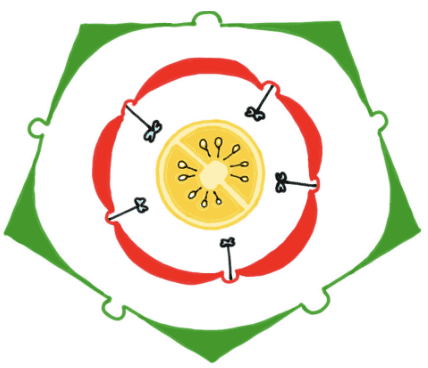
Floral diagram of Family - Solanaceae
Floral diagram of Family - Fabaceae
3. Describe the various types of placentation found in flowering plants & represent them diagrammatically.
Ans: The following are the different types of placentation is found in flowering plants: -
a) Marginal Placentation: The ovary has one chamber and the ovules are located along the ovary's margin. Example: - Pea and Gram.
b) Parietal Placentation: - Ovary is chambered, and the ovules are located at the fusion level of carpels. Example: -Mustard.
c) Axile Placentation:- The ovary has many chambers and the ovules are attached to the central column. Example: - Onion and lemon.
d) Free Central Placentation: - One chambered ovary with many ovules in the centre. Example: - Dianthus and Primula.
e) Basal Placentation: - Ovary is one chambered, and ovules develop on the thalamus. Example: - Sunflower.
f) Superficial Placentation: - The ovary is multilocular and syncarpous. Ovules grow on the minor surface of the ovary. Example: - Nymphaea.
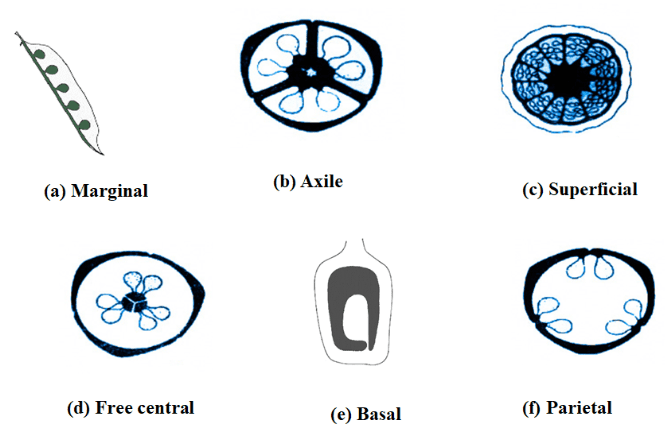
Diagrammatic representation of various types of Placentation in flowering plants
4. What is a flower? Describe the parts of typical angiosperm plants with the help of a diagram.
Ans: The flower is a modified shoot with nodes and modified floral leaves. The parts of typical angiosperm plants are: -
i. Calyx (Sepals): - It is the green outer whorl of the flower. The members of the calyx are termed sepals. It is a leaf-like structure. It performs an important role in the protection of the flower in the bud stage. It may be ‘polysepalous’ i.e., sepals free or ‘gamosepalous’ i.e., sepals united.
ii. Corolla (Petals): - It is the second whorl of the flower situated inside the sepals. The petals are usually bright and colourful. The insects are attracted to the brightly coloured petals so they add in pollination. The lower, stalk-like portion of the petal is known as a claw. The upper, extended portion is known as a limb.
iii. Androecium (male reproductive part): - Androecium, a male reproductive part of a flower, consists of the stamen. Each stamen is made up of two parts: Filament and Anther.
a) Anther: - It is a bilobed structure. Each anther lobe contains two pollen sacs. Pollen sacs produce pollen grains.
b) Filament: - It is a stalk-like structure by which anther lobes are attached is called a filament.
iv. Gynoecium (female reproductive part): - It is made up of one or more carpels. A carpel consists of 3 parts: - Stigma, Style and Ovary.
a) Stigma: - Stigma is the uppermost part of the pistil and is the receptive surface for pollen grains.
b) Style: - It is a stalk-like structure that connects the stigma to the ovary.
c) Ovary: - The basal part that bears one or more ovules attached to a flattened cushion-like placenta.
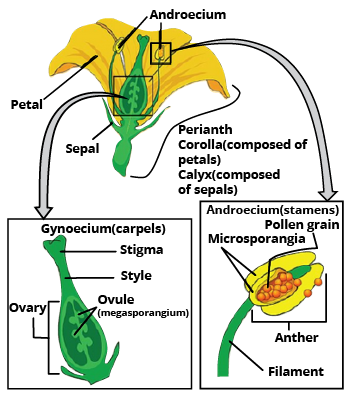
Different parts of Angiosperm plant
5. Describe the aerial modifications of the stem.
Ans: The aerial modifications of the stem are: -
a) Stem Tendril: - Stem tendrils are thin, leafless, slender-like and spirally coiled structures that develop from axillary buds. They help the plants such as cucumber, watermelon, grapevine etc. to climb.
b) Stem Thorn: - sometimes the axillary buds grow into hard, woody straight & pointed structures called thorns. It arises in the axil of the leaf or at the tip of the branch. Sometimes thorn bears leave also. Example: - Citrus, Bougainvillea etc.
c) Phylloclade: - It is the green flattened or cylindrical stem that takes the form and function of the leaf. They contain chlorophyll & carry photosynthesis. They have many nodes & internodes. Their actual leaves are scales or shortened spines. It is commonly found in xerophytic plants. Example: - Opuntia, epiphyllum etc.
d) Cladode: - This is a phylloclade of limited growth which develops, from the node of the stem or branch and in the axil of a scale leaf. Cladodes are green flat and leaf-like structures that carry on photosynthesis. Example: - Asparagus, Ruscus, etc.
e) Bulbils: - This is a modified vegetative or floral bud meant for the production of a new plant. It detaches itself from its mother plant and grows into an independent plant. Example: - Oxalis, Agave americana, Lilium.
Related Study Materials for Class 11 Biology Chapter 5
S.No | Important Other Links for Class 11 Biology Chapter 5 |
1. | |
2. |
CBSE Class 11 Biology Chapter-wise Important Questions
CBSE Class 11 Biology Chapter-wise Important Questions and Answers cover topics from all other chapters, helping students prepare thoroughly by focusing on key topics for easier revision.
Additional Study Materials for Class 11 Biology
S.No | Study Materials for Class 11 Biology |
1 | |
2 | |
3 | |
4 | CBSE Class 11 Biology Sample Papers |
Conclusion
The Class 11 Biology Morphology of Flowering Plants chapter is an essential chapter that introduces students to the structure and function of the different parts of a flowering plant. It covers topics such as the root, stem, leaf, flower, and fruit, and their adaptations to different environments. Students should pay close attention to this chapter and practice solving questions to gain a thorough understanding of the concepts. Vedantu provides comprehensive study materials, including notes, sample papers, and solutions to previous year question papers, to help students prepare for their exams. By mastering the concepts covered in this chapter, students can develop a deeper understanding of the complex structures and functions of flowering plants, which are essential for their survival and reproduction.
FAQs on Important Questions for CBSE Class 11 Biology Chapter 5 - Morphology of Flowering Plants
1. What is the importance of studying the morphology of flowering plants?
Studying the morphology of flowering plants is essential for understanding the structure and function of different plant parts. It helps in identifying and classifying different plant species and understanding their adaptations to different environments.
2. What are the different types of roots in plants?
The different types of roots in plants are tap roots, fibrous roots, adventitious roots, and aerial roots.
3. What is the function of the stem in plants?
The stem in plants provides support to the plant and helps in the transport of water, minerals, and nutrients between the roots and leaves.
4. What is the function of the leaf in plants?
The leaf in plants is responsible for photosynthesis, which is the process of converting light energy into chemical energy. It also helps in the exchange of gases and transpiration.
5. What is the function of the flower in plants?
The flower in plants is responsible for reproduction. It contains the male and female reproductive organs, which produce gametes that fuse to form seeds.
6. What is the difference between a fruit and a vegetable?
Fruits are the mature ovaries of flowering plants and contain seeds, while vegetables are any edible part of a plant, such as roots, stems, leaves, or flowers.























